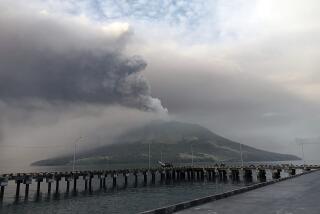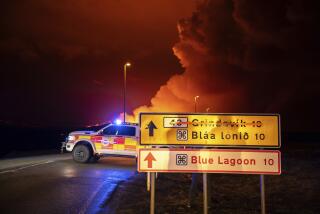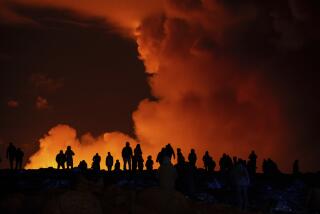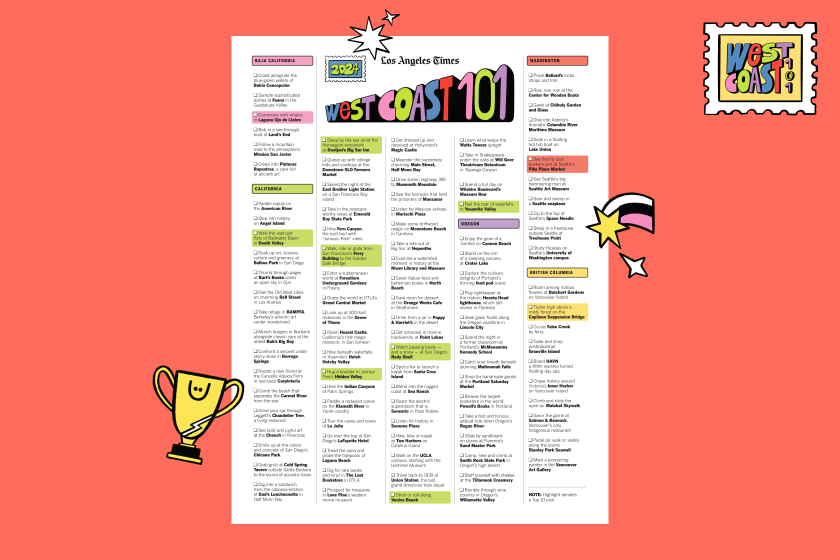News from around the world
Restless volcano may upset Europe for months
AMSTERDAM -- Even as Europe’s dormant airports sputter back to life, prudent travelers should ask: What if it happens again?
Because it might. Over and over again, for weeks, perhaps months, scientists say.
The last eruption from Iceland’s Eyjafjallajoekull, in 1821, lasted off and on for 13 months -- but back then there were no jet engines to get clogged up from volcanic residue.
What should the world brace for if ash clouds wash over European skies intermittently for six months or a year, repeatedly closing airports with just a few hours warning?
The crucial tourist industry will be devastated. Supermarkets will have less out-of-season produce. Businesses, like delivery services, will need to improvise. And everything will be more expensive.
Europe’s recovery from the economic recession likely will be set back to zero. Banks and governments, worried about runaway inflation, may tighten credit. Railways and roads will be overloaded with freight and people opting for more reliable means of travel.
Five days into the crisis, a BMW plant in Germany and a Nissan plant in Japan were forced to close temporarily because the ash cloud prevented the arrival of parts shipments. Prolonged disruptions to supply chains could have a profound effect on manufacturing and global trade.
The psychological effects of uncertainty could be numbing. As long as the volcano keeps rumbling, few people are likely to willingly risk more nightmarish delays camped out at airports or trapped in overpriced hotels.
Hotels in Bangkok sending tourists packing
BANGKOK -- Thailand’s bloody political crisis has been scaring away tourists for weeks but took a new turn Tuesday when some of the capital’s finest hotels sent guests packing for fear of violence at their doorsteps.
The Grand Hyatt and InterContinental hotels in Bangkok told guests they would have to leave, while The Four Seasons remained open but closed all four of its restaurants and saw its cavernous lobby empty except for a few wilted orchids.
The hotels took action on one of the more relaxed days in the deadlock created by anti-government demonstrators who began occupying city streets more than five weeks ago. They abandoned plans to march into the heart of the capital’s central business district Tuesday after soldiers in full combat gear were deployed to bar the way.
However, the failure to march did nothing to ease tensions. The so-called “Red Shirt” protesters reinforced defenses at their urban encampment and prepared homemade weapons, including hundreds of sharpened bamboo poles. The army in response said it would be prepared to use greater force in any confrontations because of the danger posed by the weapons.
“The situation is very tense. We are relocating guests to other hotels for their safety,” said Patty Lerdwittayaskul, a spokeswoman at the 380-room Grand Hyatt Erawan, which announced its closure until at least Saturday.
More aboard! Amtrak studies long-distance route improvements to attract more riders, money
COLUMBUS, Ohio (AP) -- In many states, travelers who take Amtrak’s long-distance trains for vacations or out-of-state business trips board in the middle of the night and return home from such cities as Chicago or New York City at times that are just as inconvenient.
But some improvements are on the way. Amtrak, the country’s only major passenger train system, is re-examining timetables and finding other ways to improve its 15 national routes to bring in more riders and revenue. Among those under review are two routes that dip into Ohio and are practically hidden at night, their trains passing through when most people are sleeping.
Businessman Dave Shreiner, 63, typically boards around 1:30 a.m. at a tiny Amtrak stop in Alliance, Ohio. He travels exclusively by rail half of the year, visiting clients around the U.S.
“It makes planning a trip a challenge,” Shreiner said.
The push for upgrades comes as Amtrak is on pace for record ridership this year, carrying a best-ever 13.6 million passengers in the first half of fiscal year 2010. That’s a 4.3-percent increase over the same period last year, and 100,000 more than 13.5 million posted in the first half of 2008, Amtrak’s previous highest ridership of 28.7 million passengers.
Amtrak cites an improving economy and high fuel prices as factors in ridership growth.
More to Read
Sign up for The Wild
We’ll help you find the best places to hike, bike and run, as well as the perfect silent spots for meditation and yoga.
You may occasionally receive promotional content from the Los Angeles Times.






